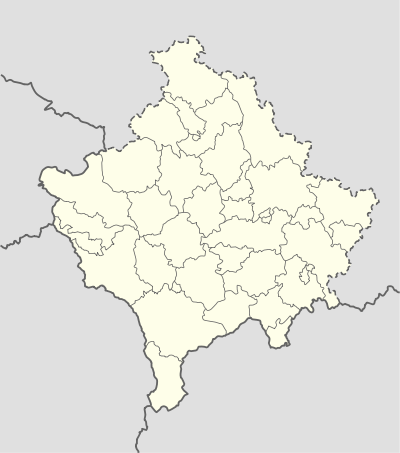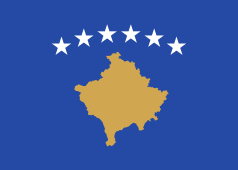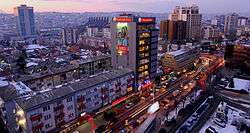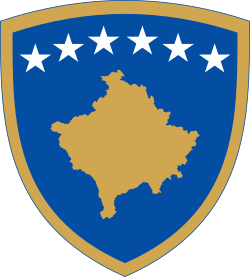Mitrovica, Kosovo
| Mitrovica Albanian: Mitrovica / Mitrovicë Serbian: Косовска Митровица / Kosovska Mitrovica | ||
|---|---|---|
| City and municipality | ||
| Mitrovica | ||
|
From top (left to right): Ibar Bridge, Sitnica river, Miners Monument, Ibar River, St. Dimitri Orthodox Church, Former Jadran Hotel, Sand's Mosque, Mitrovica at night panoramic view. | ||
| ||
 Mitrovica Location in Kosovo | ||
| Coordinates: 42°53′N 20°52′E / 42.883°N 20.867°ECoordinates: 42°53′N 20°52′E / 42.883°N 20.867°E | ||
| Country | Kosovo[lower-alpha 1] | |
| District | District of Mitrovica | |
| Government | ||
| • Mayor | Agim Bahtiri | |
| Area | ||
| • Land | 331 km2 (128 sq mi) | |
| • Urban | 15.983 km2 (6.171 sq mi) | |
| Elevation | 500 m (1,600 ft) | |
| Population (2014) | ||
| • City and municipality | 71,636 | |
| • Urban | 46,230 | |
| • Urban density | 2,900/km2 (7,500/sq mi) | |
| Time zone | CET (UTC+1) | |
| • Summer (DST) | CEST (UTC+2) | |
| Postal code | 40000 | |
| Area code(s) | +381 28 | |
| Car plates | 02 | |
Mitrovica or Kosovska Mitrovica (Albanian: Mitrovica, Mitrovicë; Serbian Cyrillic: Косовска Митровица) is a city and municipality in Kosovo.[lower-alpha 1] It is the administrative center of the District of Mitrovica. According to the 2011 Census, the total population is 71,601. However, the city was divided in 2013 and therefore the number is now far lower. Albanians make the majority of the municipality (96.6%), followed by smaller ethnic groups like Bosniaks, Turks, Roma, Ashkali and Balkan Egyptians, and others.[1]
The town is divided by the Ibar river, with the northern Serb-majority part of the city becoming a new municipality known as North Mitrovica. The Serbian part became a separate municipality in 2013, following the North Kosovo crisis.
Name
In the middles ages the city was called "Demetrius" in honour of Saint Demetrius of Thessaloniki. When the city came under Ottoman rule, it was renamed "Mitrovica", as happened to other locations in the Balkans named after Saint Demetrius.[2][3]
After President Tito's death, each of the constituent parts of Yugoslavia had to have one place named with the word 'Tito' (or 'Tito's') included, the city was then known as Titova Mitrovica (Титова Митровица) in Serbian or Mitrovica e Titos in Albanian, until 1991.
The city is now known as Mitrovica and Mitrovicë in the Albanian language and Kosovska Mitrovica (Косовска Митровица) in the Serbian language ![]() listen .
listen .
History
Early history

The city is one of the oldest known settlements in Kosovo, being first mentioned in written documents during the Middle Ages. The name Kosovska Mitrovica comes from the 14th century, from Saint Demetrius of Thessaloniki, but there are some other legends on the origin of its name. Near Mitrovica is the medieval fortress of Zvečan, which played an important role during the Kingdom of Serbia under Nemanjić rule.
Under Ottoman rule Mitrovica was a typical small Oriental city. Rapid development came in the 19th century after lead ore was discovered and mined in the region, providing what has historically been one of Kosovo largest industries.
It became an industrial town, formerly the economic centre of Kosovo because of the nearby Trepča Mines. It grew in size as a centre of trade and industry with the completion of the railway line to Skopje in 1873–1878, which linked Mitrovica to the port of Thessalonika.[4] Another line later linked the town to Belgrade and Western Europe.[4] During World War II, the city was part of Axis-occupied Serbia. In 1948, Mitrovica had a population of 13,901 and in the early 1990s of about 75,000.[4]
Mitrovica during and after the Kosovo War
Both the town and municipality were badly affected by the 1999 Kosovo War. According to the Organization for Security and Cooperation in Europe (OSCE), the area had been the scene of guerrilla activity by the Kosovo Liberation Army (KLA) prior to the war. It came under the command of NATO's French sector; 7,000 French troops were stationed in the western sector with their headquarters in Mitrovica. They were reinforced with a contingent of 1,200 troops from the United Arab Emirates, and a small number of Danish troops.
_-_Kosovo.jpg)
In the aftermath of the war, the town became a symbol of Kosovo's ethnic divisions. The badly damaged southern half of the town was repopulated by an estimated 50,000 Albanians. Their numbers have since grown with the arrival of refugees from destroyed villages in the countryside. Most of the approximately 6,000 Roma fled to Serbia, or were relocated to one of two resettlement camps, Cesmin Lug, or Osterode, in North Kosovska Mitrovica. In the north, live some 17,000 Kosovo Serbs, with 2,000 Kosovo Albanians and 1,700 Bosniaks inhabiting discrete enclaves on the north bank of the Ibar River. Almost all of the Serbs living on the south bank were displaced to North Mitrovica after the Kosovo War. In 2011, the city had an estimated total population of 71,601.
Mitrovica became the focus for ethnic clashes between the two communities, exacerbated by the presence of nationalist extremists on both sides. The bridges linking the two sides of the town were guarded by armed groups determined to prevent incursions by the other side. Because of the tense situation in the town, KFOR troops and the United Nations Interim Administration Mission in Kosovo (UNMIK) police were stationed there in large numbers to head off trouble. However, violence and harassment was often directed against members of the "wrong" ethnic community on both sides of the river, necessitating the presence of troops and police checkpoints around individual areas of the city and even in front of individual buildings.
On March 17, 2004, the drowning of an Albanian child in the river prompted major ethnic violence in the town and a Serbian teenager was killed. Demonstrations by thousands of angry Albanians and Serbs mobilised to stop them crossing the river degenerated into rioting and gunfire, leaving at least eight Albanians dead and at least 300 injured. The bloodshed sparked off the worst unrest in Kosovo seen since the end of the 1999 war (in which 11 Serbs were killed). The local prison was the scene of an international incident on 18 April 2004 when Ahmed Mustafa Ibrahim, a Jordanian policeman working as a UN prison guard, opened fire on a group of UN police officers leaving a class, killing three.[5][6]
Kosovo independence
Tensions rose considerably in the city of Mitrovica after Kosovo declared independence on 17 February 2008. Some 150 Kosovo Serb police officers refused to take orders from the ethnic Albanian authorities and were suspended.
Serb protesters prevented ethnic Albanian court employees from crossing the bridge over the Ibar River. UN police raided and seized the courthouse on March 14 using tear gas against Serbs and leaving some of them wounded.
The explosion of a hand-grenade injured several UN and NATO staff on March 17; UN forces were later withdrawn from the northern part of Mitrovica.[7]
The Serbian minority initially formed the Community Assembly of Kosovo and Metohija in the city, but it has no police force. Serbs refused to accept the jurisdiction of Kosovo courts,[8] Republic of Kosovo leaders have expressed concern over the future of the region, stating their commitment to keep Mitrovica part of Kosovo and prevent crime or war there.[9] with the 2013 Brussels Agreement Kosovo Serbs accepted the Pristina run police force and courts and vote on ballots with republic of Kosovo logos. Elected Serbs swear oaths to Republic of Kosovo.
"To build trust and confidence, Kosovo authorities need to be attentive to culture and religious symbols, such as the Serb Orthodox cemetery in Mitrovica, on the Albanian, south, bank of the Ibar. The main Albanian cemetery is in the North and intact. The Serb cemetery is devastated, hundreds of headstones in shards and the chapel at its centre desecrated and burned. Most of the damage dates to 1999 and March 2004, but also to 2007 and 2008. The site is unguarded and open to sporadic vandalism, some allegedly perpetrated by residents of a neighbouring Ashkali settlement apparently seeking to ingratiate themselves with Albanians by lashing out at Serbs. Northern Serbs often cite the two cemeteries as signs of their tolerance and Albanian hostility. The Kosovo authorities’ failure to repair and secure the graveyard sends a terrible message to Northern Serbs: this is what your future will look like, once you have integrated."[10]
Archaeological sites
The strategic position of the region of Mitrovica in the middle of two great rivers Ibar and Sitnica and its mineral wealth in Albanik (Monte Argentarum), made this location populated since prehistoric period. This region was populated by Illyrians, respectively Dardan tribe. The first data for the archaeological sites in the region of Mitrovica, begin with the researches of Sir Arthur John Evans, who was the first to pinpoint the Roman town of the Municipium Dardanourm. In the archaeological sites of the region of Mitrovica were found traces and objects from different periods such as; neolithic, Roman, late antiquity and medieval period. Objects and figurines include: fortress vestiges, necropolis, Terpsichore figure, statues, sarcophagus, altar, jewellery, etc.
Demographics
Before the 1999 Kosovo War, the municipality had a population estimated by the OSCE to comprise some 116,500 people, 81% of them Kosovo Albanian, 10% Serb and the remainder other ethnicities (notably Bosniaks and Roma). Most of the non-Albanians lived in the town of Mitrovica, which had a population of 68,000 – 71% Kosovo Albanian, with approximately 9,000 Serbs and 10,141 other nationalities. Kosovo Albanians lived throughout the city, but most Serbs lived in the north side, divided from the predominantly Albanian south side by the Ibar River.
| Ethnic Composition, Including IDPs | |||||||||||||
| Year/Population | Albanians | % | Serbs | % | Bosniaks | % | Roma/Ashkali | % | Turks | % | Total | ||
|---|---|---|---|---|---|---|---|---|---|---|---|---|---|
| 1961 | 34,481 | 57.55 | 21,533 | 35.94 | 59,913 | ||||||||
| 1991 | 82,837 | 78 | 10,698 | 10.2 | 5,205 | 4.96 | 4,851 | 4.63 | 431 | 0.41 | |||
| 1998 | 95,231 | 81.74 | 10,447 | 8.96 | |||||||||
| 2011 | 69,497 | 14 | 416 | 1175 | 518 | ||||||||
| Source: 1991 census: FRY Institute of Statistics and UNHCR statistics of 1998/OSCE estimates. It is noted that the 1991 census was highly politicised and is thus unreliable. Ref: Organization for Security and Co-operation in Europe[11] | |||||||||||||
Official languages
In Mitrovica Municipality, Albanian and Serbian are official languages, while Turkish is recognised as a language in official use.[12][13]
Economy
The Trepča Mines are located in Mitrovica, though they are not operating. With the closure of the Trepča complex, the influx of refugees and IDPs and the lack of investment, unemployment (estimated at approximately 77%) has been prevalent among all communities in the Mitrovica municipality.
Culture and education
Serbian faculties of the University of Pristina were relocated from Pristina to North Mitrovica after the Kosovo War. The City Museum of Mitrovica is located there.
Sports
Three football clubs are situated on the territory of Mitrovica: FK Partizan (in North Kosovska Mitrovica), and KF Trepça and KF Trepça'89 in south of the city. The two southern teams play in the Football Superleague of Kosovo. KF Trepça play at the Olympic Stadium Adem Jashari, which hosted Kosovo's first FIFA-recognised friendly international football match on 5 March 2014.[14]
Notable people

- Vukan, Grand Prince of Serbia
- Stefan Dečanski, King of Serbia
- Vahedin Ajeti, Albanian footballer
- Enis Alushi, Albanian football player
- Valon Behrami, Swiss international football player
- Bekim Bejta, poet and translator
- Nevena Božović, Serbian singer and Serbia's Eurosong participant
- Milan Biševac, Serbian football player
- Aleksandar Čanović, Serbian football player
- Nexhip Draga, Albanian nationalist
- Xhafer Deva, former Minister of the Interior of Albania
- Miloš Krasić, Serbian football player
- Nikola Lazetić, former Serbian football player
- Žarko Lazetić, former Serbian football player
- Rexhep Mitrovica, former Prime Minister of Albania
- Rona Nishliu, represented Albania at the Eurovision Song Contest 2012
- Riza Lushta, former Albanian football player
- Xhevat Prekazi, former football player
- Muharrem Qena, actor and singer
- Valdet Rama, Albanian footballer
- Bajram Rexhepi, politician
- Ali Shukrija, 2nd Communist Prime minister of Kosovo.
- Darko Spalević, former Serbian football player
- Borislav Stevanović, former Serbian football player
- Sulejman Ugljanin, Bosniak politician
- Stevan Stojanović, former Serbian football player
- Ymer Xhaferi, Albanian football player
- Diana Avdiu, Miss Kosovo Universe 2012 and semifinalist, Miss Universe 2012
- Erton Fejzullahu, Swedish football player
- Alban Meha, Albanian football player
International relations
Twin towns — sister cities
Mitrovica is twinned with:
 Tiranë, Tiranë County, Albania
Tiranë, Tiranë County, Albania Elbasan, Elbasan County, Albania
Elbasan, Elbasan County, Albania Shëngjin, Lezhë County, Albania
Shëngjin, Lezhë County, Albania Vučitrn, District of Mitrovica, Kosovo
Vučitrn, District of Mitrovica, Kosovo Kendari, South East Sulawesi, Indonesia
Kendari, South East Sulawesi, Indonesia Kumanovo, Kumanovo Municipality, Macedonia
Kumanovo, Kumanovo Municipality, Macedonia
See also
- North Mitrovica
- Kosovo Serb enclaves
- Romani people in Mitrovica refugee camps
- New Bridge, Mitrovica
- Monuments in Mitrovica
Notes and references
Notes:
- 1 2 Kosovo is the subject of a territorial dispute between the Republic of Kosovo and the Republic of Serbia. The Republic of Kosovo unilaterally declared independence on 17 February 2008, but Serbia continues to claim it as part of its own sovereign territory. The two governments began to normalise relations in 2013, as part of the Brussels Agreement. Kosovo has received recognition as an independent state from 110 out of 193 United Nations member states.
References:
- ↑ "2011 Census: Mitrovica (demographics)". Kosovo Agency of Statistics/OSCE.
- ↑ Civitas Sancti Demetrii
- ↑ "Kosovo's largest mosque in Mitrovica". World Bulletin. 7 July 2014. Retrieved 7 July 2014.
- 1 2 3 Elsie, Robert. Historical dictionary of Kosovo.
- ↑ Wood, Nicholas (2004-04-18). "3 U.N. Police Die in Shootout At Kosovo Jail". The New York Times. Retrieved 2008-10-15.
- ↑ "International press on the UN police shooting incident in Kosovska Mitrovica". ERP KIM Archive. Retrieved 2008-10-15.
- ↑ BBC, Peacekeepers hurt in Kosovo blast, 17.03.08
- ↑ TransConflict, Kosovo – what to do with the north, ad interim, April 2010
- ↑ UNMIK Headlines, March 2, 2009
- ↑ North Kosovo: Dual Sovereignty in Practice. N°21. Crisis Group Europe Report. 14 March 2011. p. 11.
- ↑ "Mitrovicë/Mitrovica" (PDF).
- ↑ "Implementation of the Law on the Use of Languages by Kosovo Municipalities" (PDF). June 2008.
- ↑ http://www.osce.org/kosovo/32762
- ↑ "Kosovo draw with Haiti on international bow".
External links
| Wikimedia Commons has media related to Mitrovica, Kosovo. |
| Wikivoyage has a travel guide for Mitrovica. |
- Photo essay about serbian part of Mitrovica (2011)
- OSCE:Profile of Mitrovicë / Mitrovica
- Municipality of Mitrovica in the Republic of Kosovo
- Mitrovica North Administrative Office Official Website
- North Kosovska Mitrovica Official Website
- Jazz & Blues Festival North City
- HCIC, Mitrovica Situation – HCIC, UNHCR, WEU, KFOR (22 Mar 2000)
- Mitrovica Situation – HCIC, UNHCR, WEU, KFOR (24 Feb 2000)
- Mitrovica: North and South of a Divided City Video about displacement and reconstruction in Mitrovica.
- Burning of St. Sava church in south Mitrovica 17 March
- Andrew Purvis (2008-06-04). "Postcard from Mitrovica: Almost Mellow at Kosovo's Front-Line Cafe". TIME Magazine. Retrieved 2010-05-17.
- ESI report: People Or Territory? A Proposal For Mitrovica (16 February 2004)
| | |||||||||
|---|---|---|---|---|---|---|---|---|---|
| Rank | Name | Districts | Pop. | Rank | Name | Districts | Pop. | ||
 Pristina Prizren |
1 | Pristina | Pristina | 210,722 | 11 | Glogovac (Drenas) | Pristina | 61,522 |  Ferizaj (Uroševac)  Peć |
| 2 | Prizren | Prizren | 186,860 | 12 | Lipljan | Pristina | 60,517 | ||
| 3 | Ferizaj (Uroševac) | Ferizaj (Uroševac) | 114,087 | 13 | Orahovac | Gjakova | 59,021 | ||
| 4 | Peć | Peć | 100,081 | 14 | Mališevo | Prizren | 58,198 | ||
| 5 | Gjakova | Gjakova | 98,240 | 15 | Skenderaj (Srbica) | Mitrovica | 52,951 | ||
| 6 | Gjilan | Gjilan | 93,291 | 16 | Vitina | Gjilan | 48,861 | ||
| 7 | Podujevo | Pristina | 91,642 | 17 | Deçan | Peć | 41,523 | ||
| 8 | Mitrovica | Mitrovica | 85,910 | 18 | Istok | Peć | 40,935 | ||
| 9 | Vučitrn | Mitrovica | 72,780 | 19 | Klina | Peć | 40,675 | ||
| 10 | Suva Reka | Prizren | 62,913 | 20 | Kosovo Polje (Fushë Kosova) | Pristina | 38,265 | ||

